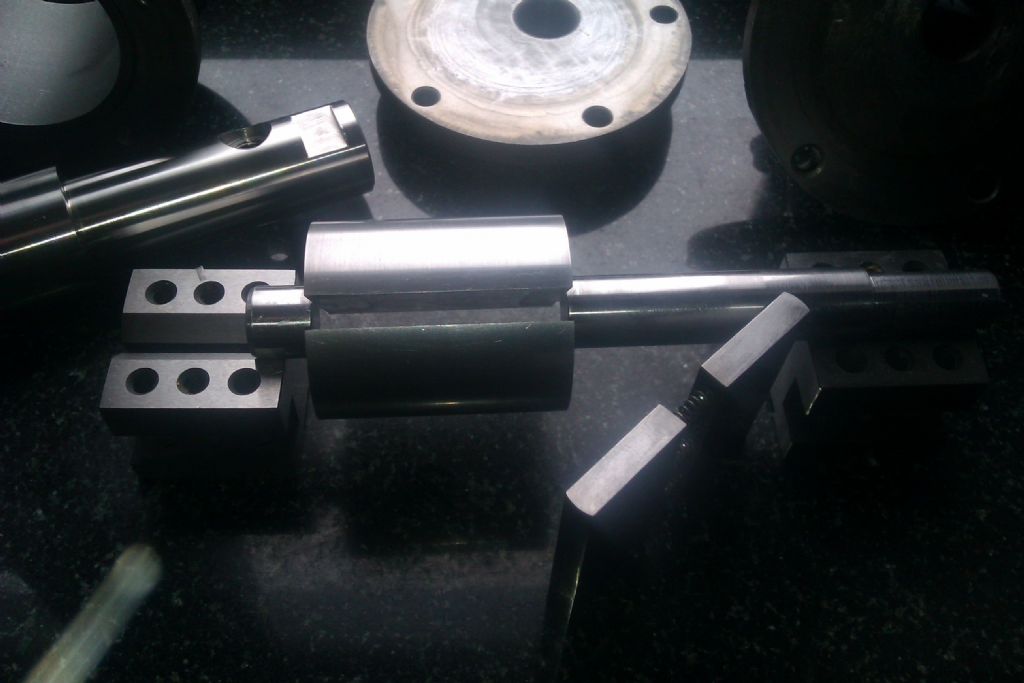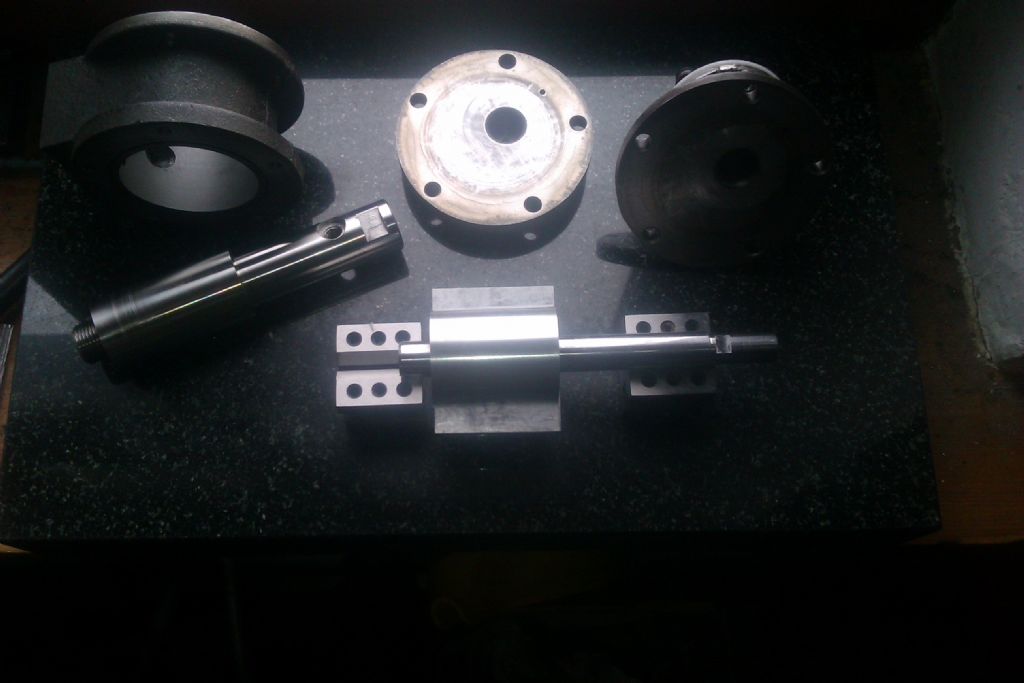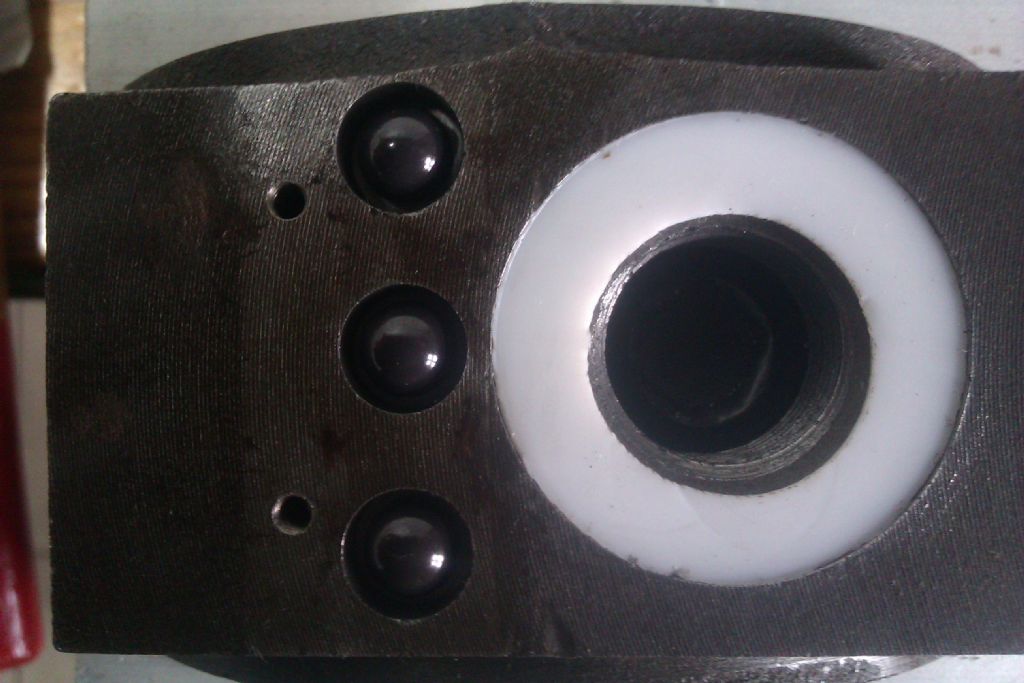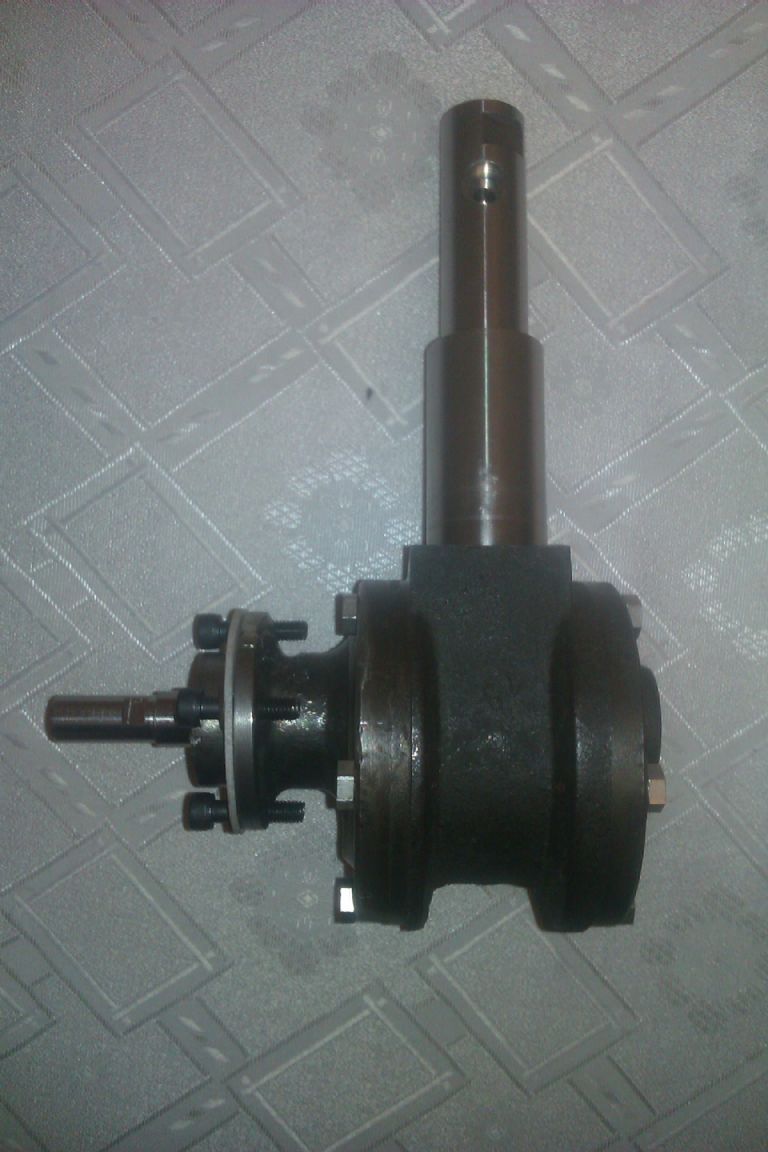Member postings for Martin Dowing
Here is a list of all the postings Martin Dowing has made in our forums. Click on a thread name to jump to the thread.
| Thread: Correct / best way to make shim washers? |
| 05/02/2023 18:10:08 |
I am using hole puncher normally applicaple for punching rubber or PTFE washers but only on rather thin shimstock. Works OK. |
| Thread: Leadscrews and other features of Asian milling machines |
| 16/09/2021 21:23:43 |
Many thanks for comments up to date. They are interesting. DRO will be a good feature but up to date I am used to handwheels. Lets hope I will quickly get used to DRO as well. I am aware it is superior. So it seems that flaking for oil control was done rather than scraping. I have seen installed "hardened, rolled super precision leadscrew" ex McMaster Carr fitted on one S7 Myford lathe. Owner is very proud of it. and declares that accuracy of screws he makes is now improved. Regarding speeds of the mill I plan to buy - seller says that after few monhs of initial use I may go up to 60 Hz to get maximum 2100 rpm if desired and machine will take it without trouble. Seems a good idea, but can I trust him? At high speeds cutters are small, loads on bearings low so it looks reasonable. Also the same machines sold under different brand names are likely to be run in US where they have 60 Hz anyway but... |
| 16/09/2021 14:55:00 |
I am about to buy medium size Asian milling machine. Its weight is about 1 ton and between few features which are nice I have found one a bit worrying - its leadscrews are turned rather than ground or rolled. It has a table 1000 x 240 mm, power feed in x and y axis. It can travel 590 mm in axis X and 205 mm in axis Y. Seller says that I don't need to worry about turned leadscrews because table is quite heavy (approx 60 kg) and ground or rolled leadscrews would quickly lose their advantage, unless they are hardened and further surface treated what would make them very expensive. He is confident that accuracy will be good for long time regardless and he points out that machine has DRO anyway. DRO is handy but I would like if readuts from dials on handwheels can be trusted as well Dovetails of this machine are scraped but only on 1 of 2 mating surfaces. Seller says that 1 scraped surface still holds enough oil to work with second ground one and it is still beter than if not scraped at all. Mill is trammed well (0.02mm TIR on 200mm diameter), at least in the case of one in display room and machine "eat the meat" without any noticeable fuss or chatter. Gearbox is quiet. Has 2 spindles (vertical and horizontal), good selection of speeds beginning from 115 up to 1750 rpm on vertical spindle and from 60 to 1350 rpm on horizontal. You can rise and lower main table total 350mm. Quill has a strike of 120 mm and is located in head of swiveling type. 2hp motor. Everything cost equivalent of 5500 queeds including VAT. What do you think about these worrying "features" of leadscrews and one of 2 mating dovetails surfaces scraped? What more to look for before buying?
|
| Thread: Drunken pulley |
| 16/04/2021 07:57:01 |
@not done it yet. It was left in my dad's shed and forgotten. Seen daylight again only recently. @Robert. Definitely pulley. Other pulley fit on this shaft doesn't wobble but I need this pulley for something else. @Hopper, Pump was not used for very long time, possibly for 40 years, so I will have to test it after running it for an hour or so. But thanks for your remarks. There is a belt guard, so it doesn't annoy my eye once covered. |
| 15/04/2021 19:31:29 |
Thanks for comments, all of you. It is also very annoying for me and I will bore hole and install a bush like all of you are suggesting. Martin Edit: Howard, I will fit bush easy - have access to liquid nitrogen if needed. Tried few times and interference fit is very nicely made. Loctite or that. I am considering loctite because pulley is made of cast iron and interference fit could crack it. Pulley is not from lathe. Just 50 years old pump. There is a belt guard so it would not be seen while working. Still very annoying. Martin Edited By Martin Dowing on 15/04/2021 19:56:33 |
| 15/04/2021 13:53:57 |
I have one old machine which has a pulley problem. Hole for axis is not true to tthe plane on which transmission belt works and this results in wobbling. Pulley works with V-belt and has 5 inch diameter and a "total runout" of wobble is 2mm (~1/12 inch). Distance between centers of both pulleys is 10 inches and second pulley has a diameter of 1-1/2 inch. Quite annoying situation. Would you leave it as it is or repair faulty pulley by drilling larger hole, soldering in or loctiting core and drilling it again? Does such a wobble affect bearings causing faster wear or can it be ignored? What about expected wear of transmission belt? Many thanks for any comments. |
| Thread: What Did You Do Today 2021 |
| 18/03/2021 21:53:00 |
Continuation: Few more photos: |
| 18/03/2021 21:41:47 |
|
From time to time I was busy with repairing rotary vacuum pumps for a a guy who is servicing these. This was usually involving making stellite ball valve seats to work with ceramic balls. Such valve is virtually indestructable. Hovever I got one small old fashioned pump which had spindle damaged and was completely naked. He gave it to me as "irreparable - do with it what you want". So I have enlarged damaged working bore a bit (turning and honing), made from scratch new spindle which is of very interesting construction, made sliders which fit into a slotted section of spindle, replaced valve seats and balls as usual into stellite - ceramic set and pump was assembled. Also bearing bore was lapped and a flange used for bolting of pump to its oil tank was repaired by welding. So really I can say that I have made new pump from castings. Spindle and sliders were made of 45 HRc material. Already tested and it easily goes down to 0.01 mbar - pretty good. Taken quite a while to make it - few linear dimensions had to be made up to a single thou tolerance.
Edited By Martin Dowing on 18/03/2021 21:42:51 Edited By Martin Dowing on 18/03/2021 21:49:03 Edited By Martin Dowing on 18/03/2021 21:51:24 |
| Thread: Flat bottomed hole with a boring bar - technique? |
| 13/03/2021 17:03:46 |
Posted by Hopper on 13/03/2021 13:37:08:
No worms harmed in the making of this post. Myford User Manual says a 6" test piece should measure "the same diameter at both ends" when adjusting the bed "levelling". Myford inspection sheet allows 0 to 6/10ths of a thou over 6" misalignment between headtsock spindle and bed, toward the direction of the tool bit. 0 would be the value you ideally aim at. 6/10ths would be the maximum error you are allowed if you fail to achieve the ideal of 0. This would then be followed by the above levelling process to obtain 0-0 on the actual turning test. Conelly in "Machine Tool Reconditioning" allows 8/10th of a thou per foot variation but allows it to be in any direction. I think Schlessinger is something similar. So over a 1" deep hole that would be about 8/100ths of a thou of taper, or less. Roughly. Nowhere I have seen says a "properly" set up lathe is set to turn bigger at one end than the other. I have difficulty trying to imagine why you would deliberately set a lathe up to do that.
Lathe set to produce tailstock end of bar larger in diameter than a headstock one will also produce Morse socket like bore at opening with front tooling and it is a preferable situation if piston entering bore meets gradually increasing resitance (easier to rectify) than large resistance at he entry followed by dropping in a bit further down a bore. About these and other practices (including up to 3 thou taper per foot) i was told by a guy who was working few decades in Myford, N'gham, while it still existed. According to him ML7 with 3 thou a foot of taper would still be passed by inspector albeit most of assembled lathes were doing much better than that, typically ~ 1 thou a foot. Martin Edit: Perhaps discrepancy of our data is related to bed straighness versus assembled lathe straightness. Edited By Martin Dowing on 13/03/2021 17:09:06 |
| 13/03/2021 08:37:05 |
Posted by Hopper on 13/03/2021 03:58:14:
Posted by Martin Dowing on 12/03/2021 23:35:00
Normally such a hole would have lower diameter on entry than on the bottom (assuming lathe is set properly, eg to turn bar in such a way that diameter grows towards right end of bar).
What? How does that work? Lathes are usually set to turn parallel are they not? Not really. There is someting like 0.5 - 3 thou per foot taper. Myford specificaion says about "up to 3 thou per foot". It is usually "less" but inspector would pass such a lathe as well (my is turning a taper about 0.5 thou per foot). This taper is set in such a way that diameter of turned bar increases towards tailstock. This implies that hole turned with front tooling would resemble lets say Morse tapper (of course not near this steep). With rear tooling the opposite is true. Lathe which would turn bar *narrowing* towards tailstock would be sent for rebuilding (headstock re-allignement) by inspector - not acceptable. Comparable rule applies with facing - lathe is designed to give slight concavity with front tooling. Martin
|
| 12/03/2021 23:35:00 |
Posted by Clive Brown 1 on 12/03/2021 13:01:40:
If I needed a flat bottomed hole and it was less than, say, 12mm or so dia. I'd probably use either a slot drill of matching diameter for relatively shallow holes or a home-made silver steel D-bit for deeper holes. Slot drill does not produce FB hole. Bottom is going to be convex. OTOH boring bar will produce such an animal (or something very close to). Martin Edit: I would go around a problem presented by OP by frist relieving taper with sharp tool, shallow cut going down to bottom and then facing bottom with boring bar and final 2-5 thou cut while boring bar is retracting. It can also be found (at least on my lathe) that truly parallel hole (or somehing very close to one) is produced by inverted bar cutting on wall farther from operator. Normally such a hole would have lower diameter on entry than on the bottom (assuming lathe is set properly, eg to turn bar in such a way that diameter grows towards right end of bar). However minute deflection of bar is compensated for by doing so and hole ends up parallel with carful, shallow finishing cut. Martin Edited By Martin Dowing on 12/03/2021 23:50:21 |
| Thread: What is running-in oil? |
| 11/03/2021 19:37:50 |
Posted by Oily Rag on 10/03/2021 23:48:01:
Don't do it! Abrasive pastes will embed into the soft bearing material and cause premature wear. Run it as is - if it turns OK without binding it will bed in. One other point to add to your list of qualities of lubrication - probably only second in order of importance as friction reduction is the cooling action of the lubricant. Martin I didn't try it yet, but I have been advised on this forum that abrasive pase which wears itself and breake down fast and can be run into mating parts *does* exist and it is called Timesaver(TM) lapping paste available in the UK. So maybe try that as a small additive? I would like for someone more experienced to comment on that though. Martin |
| Thread: Machining phosphor bronzes |
| 04/03/2021 22:36:06 |
Many thanks for all your comments. @David, Will try your mehod of drill grinding next time. @Ramon, Yes, that was my phosphor bronze - very much like material you describe. Interestingly turning and parting off, very much like boring is rouble free. It is drilling what is problematic. Did you or anyone else have tried to tap this material btw? Also many thanks for comments of some of you that "small pilot hole is a good pilot hole" and Neil's remarks about usefulness of predrilling in such situation in general. Martin |
| 03/03/2021 22:45:22 |
Some of them are nice and others are pig. I got one difficult sample. It turns well to a nice finish, will part off and drill with small (up to 5-8 mm drills). However drilling with larger drills or slot drills ends up in failure, regardless how sharp they are. Regrinding doesnt help either. I predrilled 8mm and tried to open up bore up to 12 mm and this was of most horrible drilling experiences I ever had, even if successful after long struggling. Drill just doesnt want to cut and that's it. It is not a very hard material either but now I better understand why it is so good for bearings. Do you have any ideas why it behaves so or know tricks around it? |
| Thread: PTFE Rod |
| 03/03/2021 22:24:36 |
Posted by Mark Rea on 22/02/2021 21:39:05:
Wear a mask whilst machining PTFE. The dust is no good for you at all. Dust like dust - not good but not very dangerous either. What *is* important is to avoid smoking while machining PTFE. Dust go to cigaret, undergo thermal depolymerization and very toxic gas known as perfluoroisobutene is formed. It is about an order of magniude more toxic than phosgene, and even very small quantities can make one very sick or kill. Canaries are dying in kitchens where housewives are carelessly using PTFE coated frying pans for a good reason. Martin |
| Thread: Inherited ML7 in need of some love - where to start? |
| 03/03/2021 21:41:12 |
Posted by Tom Grace on 02/03/2021 04:38:30:
Afternoon all I recently inherited my grandfathers lathe that has been sitting in storage for the last 25 years. It’s pretty gunked up and has accumulated some rust, sawdust, dust and grime. In short - its a restoration project! Something to keep me busy for the next few years worth of weekends 😉 The manual I can find online for ml7’s is dated recently (1997) but obviously older. Based on the serial - K2276 - this machine was early; 1946-1948 era. So my question is (apart from where to start!) - what would this have looked like when it came out of the box? Is the 1997 manual appropriate? Thanks for your help Tom When I got my ML7 about 17 years ago first job done was stripping it all apart, washing eveythyhing with the exception of bed and electric motor with petrol by immersion. and washing bed with petrol soaked rugs. Because paintwork on my machine was damaged badly I have stripped all of it from bed and all parts with the eception of those made of aluminium which were OK. For bed (after intelligent protection of bedways and other machined parts etc) sand blast was used, everything else was done with drill/angle grinder & wire brushes. Attention was paid to detail in removing old paint from all corners and hidden places - quite perplexing Then all parts ready to repainting were washed by brushing under immersion in isopropanol and dichloromethane. This time bed got the same treatment and only motor was cleaned with rugs. Then epoxy based industrial paint applicable in mining industry and not available from shop to public was used immediately according to manufacturer specification. Immediately - to prevent flash rust. Being chemical engineer I don't have problems with that. Then machine was reassembled and many things including bedways, saddle etc was rescraped. One guy from trade who has biax and is profficient with i done it for me. Gib strips were replaced too. Then spindle and damaged bearing was replaced into phosphor bronze version and then machine became usable. Much more was corrected as time pass and now my lathe keeps specifications as new. At that time Myford (Nottingham) was still operational, so many spare parts I got easy and of good quality. So really my ML7 started as a set of castings. Martin Edited By Martin Dowing on 03/03/2021 21:43:28 |
| Thread: Metric feedscrews for ML7 /S7 |
| 02/03/2021 11:41:49 |
@Hopper, I will rather need to cut it. It is bent across threaded section and badly. He dropped something heavy on it. I will only need to find a way to find if it is 29 or 30 degree angle. @John Haine, Standard metric sizes of trapezoid screws are 8 and 10 mm @ 30 deg. |
| 02/03/2021 10:31:21 |
Posted by John Haine on 02/03/2021 10:16:02:
Well, that indicates that it is more likely to be made to a nominal metric diameter surely? At 9.8mm you would have a point, but at 9.56 - unlikely. I have an original imperial 3/8 inch / 20TPI ACME feedscrew made by Myford (Nottingham). It has diameter exactly 9.52 mm. Applying your logic it should have diameter 9 - 9.1 mm.
|
| 02/03/2021 09:18:50 |
Posted by John Haine on 02/03/2021 08:50:50:
How did you measure it? 3/8" = 9.525 mm, 9.5mm = .374 in. With micrometer (Starrett 0-25mm), across threaded section. Result: 9.56mm Edit: @Jason, Thanks for this comment but I would not take a risk to test click it to find out for sure. I bet they would find one facing such opportunity. Edited By Martin Dowing on 02/03/2021 09:27:53 |
| 02/03/2021 08:38:07 |
Posted by Hopper on 02/03/2021 07:58:10:
So this is the cross slide feed screw? Sounds like a Myford special made as a cost saving measure on their imperial thread roller fitted with metric rollers, if it is in fact 3/8 diameter and 2mm pitch. If so you have three choices: 1. Buy new Myford parts, if / when available -- at the Myford price. 2. Substitute some 10mm x 2mm pitch trapezoidal threaded bar and matching nut which is readily available but will need machining to suit the Myford handle and dial and the nut will need modding too. Or make your own nut using tap from Tracy Tools etc. 3. Repair the existing damaged screw, which you have not described in detail. The usual dodge is to cut the handle end off the screw, flip the threaded section around 180 degrees and attach handle to the other end. Usually done by drilling and reaming a hole in the ends of each piece and inserting a pin to join the two pieces, which is then silver soldered, loctited or pinned in position. Edited By Hopper on 02/03/2021 07:59:15 I have such metric screws on my machine for a long time and there are no issues with them. When I made an upgrade to long cross slide and "modern" looking top slide long time ago I got it all in metric forms. However my friend brought to me damaged (bent) metric feedscrew from his topslide and asked me to make duplicate. Then I have started measuring and found something weird - mixed metric - imperial design. Myford sells them but they are calling close to 1000 quids on ebay (!!!) and anyway "new Myford" stuff usually is not really a match for original parts. Once I have ordered myself replacement tailstock barrel and it came with badly scored 2MT socket, damaged as new. After complaining they replaced it but meantime I have made one myself, even better in quality than what they sent and also made of 45 HRC material but with only short section of ACME thread - suitable for lever operated tailstock. |
Want the latest issue of Model Engineer or Model Engineers' Workshop? Use our magazine locator links to find your nearest stockist!
Sign up to our newsletter and get a free digital issue.
You can unsubscribe at anytime. View our privacy policy at www.mortons.co.uk/privacy
- hemingway ball turner
04/07/2025 14:40:26 - *Oct 2023: FORUM MIGRATION TIMELINE*
05/10/2023 07:57:11 - Making ER11 collet chuck
05/10/2023 07:56:24 - What did you do today? 2023
05/10/2023 07:25:01 - Orrery
05/10/2023 06:00:41 - Wera hand-tools
05/10/2023 05:47:07 - New member
05/10/2023 04:40:11 - Problems with external pot on at1 vfd
05/10/2023 00:06:32 - Drain plug
04/10/2023 23:36:17 - digi phase converter for 10 machines.....
04/10/2023 23:13:48 - More Latest Posts...
- View All Topics
- Reeves** - Rebuilt Royal Scot by Martin Evans
by John Broughton
£300.00 - BRITANNIA 5" GAUGE James Perrier
by Jon Seabright 1
£2,500.00 - Drill Grinder - for restoration
by Nigel Graham 2
£0.00 - WARCO WM18 MILLING MACHINE
by Alex Chudley
£1,200.00 - MYFORD SUPER 7 LATHE
by Alex Chudley
£2,000.00 - More "For Sale" Ads...
- D1-3 backplate
by Michael Horley
Price Not Specified - fixed steady for a Colchester bantam mark1 800
by George Jervis
Price Not Specified - lbsc pansy
by JACK SIDEBOTHAM
Price Not Specified - Pratt Burnerd multifit chuck key.
by Tim Riome
Price Not Specified - BANDSAW BLADE WELDER
by HUGH
Price Not Specified - More "Wanted" Ads...
Do you want to contact the Model Engineer and Model Engineers' Workshop team?
You can contact us by phone, mail or email about the magazines including becoming a contributor, submitting reader's letters or making queries about articles. You can also get in touch about this website, advertising or other general issues.
Click THIS LINK for full contact details.
For subscription issues please see THIS LINK.
Model Engineer Magazine
- Percival Marshall
- M.E. History
- LittleLEC
- M.E. Clock
ME Workshop
- An Adcock
- & Shipley
- Horizontal
- Mill
Subscribe Now
- Great savings
- Delivered to your door
Pre-order your copy!
- Delivered to your doorstep!
- Free UK delivery!













 Register
Register Log-in
Log-in


